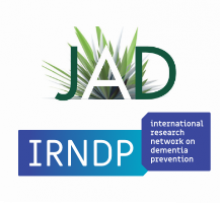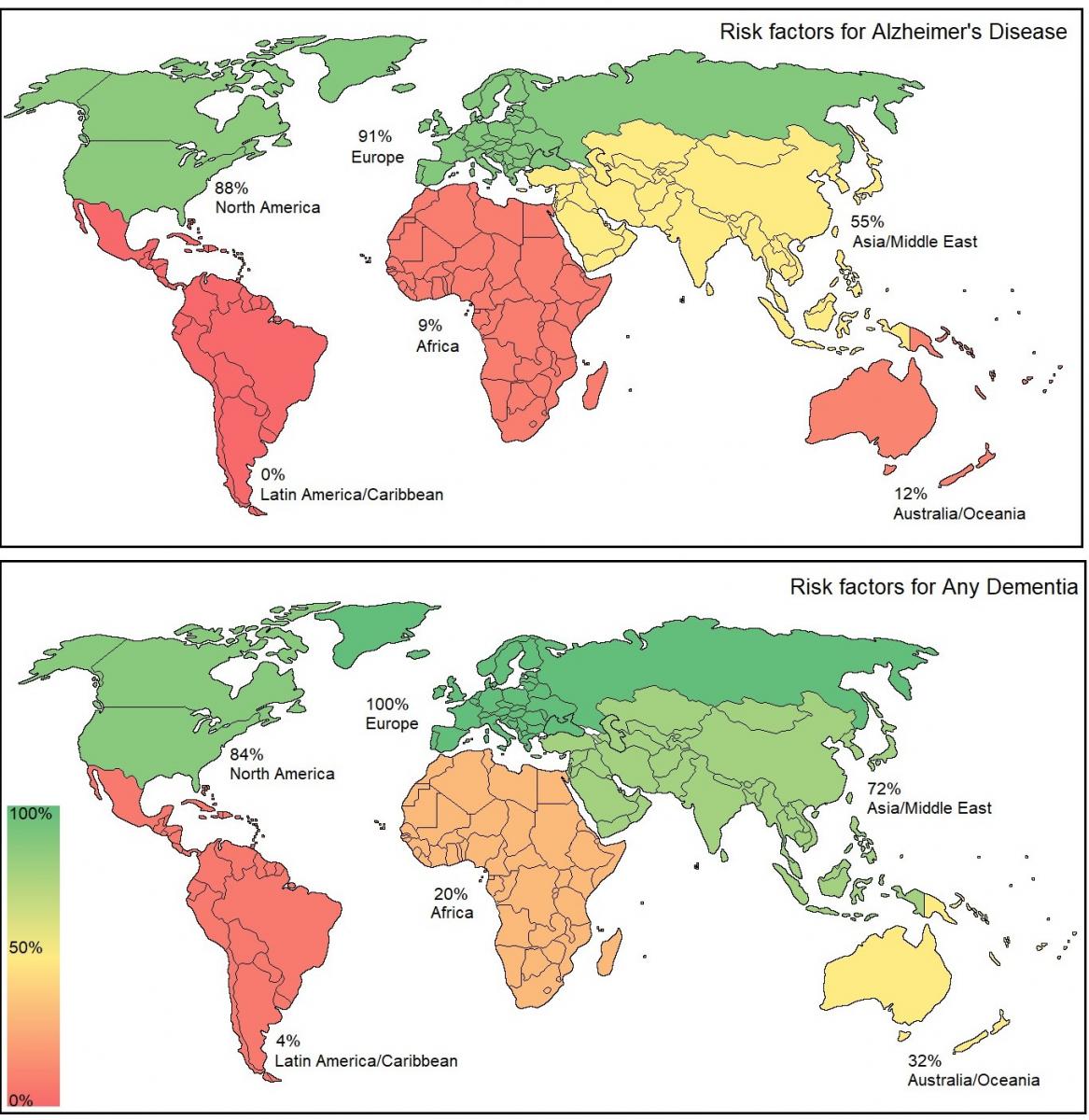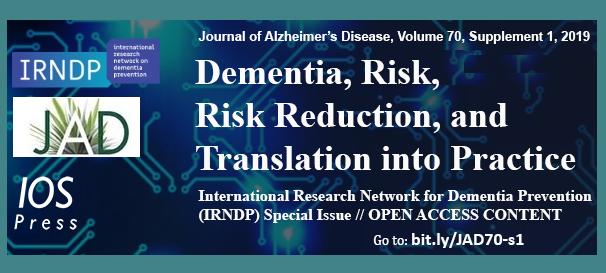3 September 2019

Noted experts report on the latest research into potential risk factors for dementia and how to reduce these risks in this JAD special supplement from the International Research Network on Dementia Prevention (IRNDP)
Amsterdam, NL – Globally, dementia cases are increasing at a rate of more than 20% a year. Most of these cases are in low- to middle-income countries. In an open access special supplement to the Journal of Alzheimer's Disease from the International Research Network on Dementia Prevention (IRNDP), an international group of scientists presents new research from around the world examining the potential risk factors for dementia and how to reduce them.
“This IRNDP issue demonstrates impressive progress in dementia prevention research and provides an invaluable collation of recent research and an up-to-date overview of the dementia prevention evidence base,” commented Guest Editors Ruth Peters, PhD, and Kaarin Anstey, PhD, both of the University of New South Wales and Neuroscience Research Australia (NeuRA), Sydney, Australia. “It also serves to highlight the substantial remaining evidence gaps and the next steps forward in this area of research. We have already achieved a lot, but now is the time to refine and develop our understanding to be able to build the next generation of dementia risk reduction interventions with translatable and applicable policies to protect human cognitive health.”
With no cure for neurodegeneration or the diseases that cause dementia, there is an urgent need to link both knowledge translation and researchers more closely together in a global effort to tackle prevention more effectively. In this issue noted experts around the globe report on some of the ongoing and crucial risk reduction trials and highlight some of the population level considerations and the remaining evidence gaps.
“Alzheimer’s disease (AD) is increasingly recognized as a chronic age related disease resulting in part from a lifetime of what we do and do not do. There may be no magic pill or vaccine to cure AD, but there can be a lifetime of prevention. Evidence-based guidance of best practices is essential as we work to improve brain health throughout the world,” noted George Perry, PhD, University of Texas at San Antonio, USA, and Editor-in-Chief of the Journal of Alzheimer’s Disease.
Up to 30% of all late-life dementia is believed to be attributable to potentially modifiable risk factors. Risk factors for dementia include obesity, social isolation, and vascular and lifestyle factors such as diabetes or smoking. Other factors recently linked to dementia risk include poor kidney function, chronic obstructive pulmonary disease, sleep disorders, and air pollution.
Ruth Peters and colleagues examine evidence associating air pollution with later cognitive decline and dementia. Exposure to air pollution, especially fine particulate matter, is associated with factors such as inflammation, and higher cardiovascular risk including risk of stroke, which also raise the risk of cognitive decline and dementia. They conclude there is evidence to suggest a link, and that while more research is needed, further regulation and reduction of exposure has huge potential for health benefits and cost savings including potentially reducing dementia risk. “The growing evidence linking pollution to dementia emphasizes the need to address this problem,” noted Dr. Peters.
Articles on risk reduction report on protocols for two of the many ongoing trials in dementia risk reduction: the Systematic Multi-Domain Alzheimer’s Risk Reduction Trial (SMARRT) and the Maintain Your Brain trial; important adherence data from the Australian Imaging Biomarkers and Lifestyle (AIBL) active-study; and an evaluation of an online health education tool for older adults in Malaysia. An associated editorial raises related questions on future trial design, intensity of intervention, and populations to target.
Contributors also examine some of the gaps in the evidence and draw attention to the lack of data across age ranges and in global populations. In a major, and important, synthesis of the global observational literature on risk factors for dementia, Kaarin Anstey and colleagues pull together the results of 40 systematic reviews. They summarize risk factors for AD, vascular dementia, and any dementia and highlight the lack of evidence for many risk factor exposures in midlife and a lack of data on risk factors for vascular dementia and from low- and middle-income countries. They identify important gaps in the literature and map out the findings in relation to age of exposure and geographical region. A related editorial focuses on the need for a life-course understanding and the importance of risk factor prevalence or saturation in particular populations or those with relatively small numbers (such as indigenous Australian populations). “Working together globally to understand risk factors for dementia relevant to specific populations, and how to bring about population level change in levels of risk, are key goals of the IRNDP,” commented Dr. Anstey.
Further articles report on population-based approaches to dementia risk reduction in different countries including Canada, the United States, the United Kingdom, Portugal, Mozambique, and Brazil. The identification of potentially hidden cases in Japanese communities and the importance of understanding the patterns of risk factor exposure, lifestyle, and available resources in different communities are highlighted in articles by Kenichi Meguro, MD, PhD, Tohoku University, Japan, and Deborah Oliveira, PhD, Federal University of Sao Paulo, Brazil, and University of Nottingham, UK. Oliveira and colleagues compare the population-attributable risk for common risk factors in three very different Portuguese speaking countries, adding important data from low- and middle-income countries and demonstrating the variation in risk factor distribution between countries.
They point out that, after adjusting for non-independence of risk factors, 24% to 40% of dementia cases could be related to seven potentially modifiable risk factors in Mozambique, Brazil, and Portugal: low educational attainment, physical inactivity, midlife hypertension, midlife obesity, depression, smoking, and diabetes. Reducing the prevalence of each risk factor by 20% per decade could, by 2050, potentially reduce the prevalence of dementia in Mozambique, Brazil, and Portugal by 12.9%, 16.2%, and 19.5%, respectively. An associated editorial draws together the key threads in this area and highlights the nuanced nature of practical dementia risk reduction, observing that in the absence of disease-modifying treatments, population-based approaches examining dementia prevention have the potential to play a key role in reducing the incidence and impact of dementia worldwide.

Percentage of reviewed dementia risk factors for which evidence is available from different geographic regions of the world
“There are lots of exciting interventions underway and the field is now burgeoning with exciting new findings that can help develop practical advice on dementia risk reduction,” noted Dr. Peters. “We expect results of several large interventions to become available in the next three to five years and are hopeful that will lead to significant advances.”
“Working together globally will accelerate discovery and implementation,” added Dr. Anstey. “Gathering evidence that is relevant to specific population groups and that can be translated into culturally acceptable and specific interventions is crucial. Science needs to inform policy and public messaging.
“Dementia risk factors come from multiple domains and it will take a concerted, interdisciplinary approach to tackle at local, national and global levels. Communication strategies for risk reduction will need to be culturally and country specific, and intervention work in this field is still preliminary in terms of demonstrating that dementia can be delayed or prevented. There is much work to be done!”
###
NOTES FOR EDITORS
Open Access Issue: Dementia, Risk, Risk Reduction, and Translation into Practice: An International Research Network for Dementia Prevention (IRNDP) Special Issue
Journal of Alzheimer's Disease, Volume 70, Supplement 1, 2019
Guest Editors: Ruth Peters, PhD, and Kaarin Anstey, PhD, both of the University of New South Wales and Neuroscience Research Australia, Sydney, Australia.
Content: https://content.iospress.com/journals/journal-of-alzheimers-disease/70/s1
The articles in this IRNDP special issue appear in Journal of Alzheimer’s Disease, Volume 70, Supplement 1 published by IOS Press. The supplement is openly available. To read more about the content of this open access issue, view the JAD mailing here.
Contact
For further information please contact Diana Murray, IOS Press (+1 718-640-5678 or d.murray@iospress.com). To reach the Guest Editors or the authors of specific papers contact Kaarin Anstey, PhD (k.anstey@unsw.edu.au), Ruth Peters, PhD (r.peters@neura.edu.au), or David Crisante, NeuRA Media Manager (+61 433 943 014 or media@neura.edu.au). For questions about Journal of Alzheimer’s Disease, please contact Editor-in-Chief George Perry, PhD, Chief Scientist of the Brain Health Consortium, The University of Texas at San Antonio (+1 210-458-4450 or george.perry@utsa.edu).
About IRNDP
Founded in 2017, the International Research Network on Dementia Prevention (IRNDP) is a multinational network bringing together researchers who are working to reduce the risk of dementia across the world. IRNDP is the first single collaborative network of researchers to focus attention on prevention that is truly global. irndp.com
ABOUT THE JOURNAL OF ALZHEIMER’S DISEASE (JAD)
Now in its 22nd year of publication, the Journal of Alzheimer's Disease is an international multidisciplinary journal to facilitate progress in understanding the etiology, pathogenesis, epidemiology, genetics, behavior, treatment, and psychology of Alzheimer's disease. The journal publishes research reports, reviews, short communications, book reviews, and letters-to-the-editor. Groundbreaking research that has appeared in the journal includes novel therapeutic targets, mechanisms of disease, and clinical trial outcomes. The Journal of Alzheimer's Disease has a 2018 Journal Impact Factor of 3.517 according to Journal Citation Reports (Web of Science Group, 2019). JAD is published by IOS Press. www.j-alz.com
ABOUT IOS PRESS
IOS Press is headquartered in Amsterdam with satellite offices in the USA, Germany, India and China and serves the information needs of scientific and medical communities worldwide. IOS Press now publishes more than 80 international peer-reviewed journals and about 75 book titles each year on subjects ranging from computer science, artificial intelligence, and engineering to medicine, neuroscience, and cancer research. www.iospress.com








